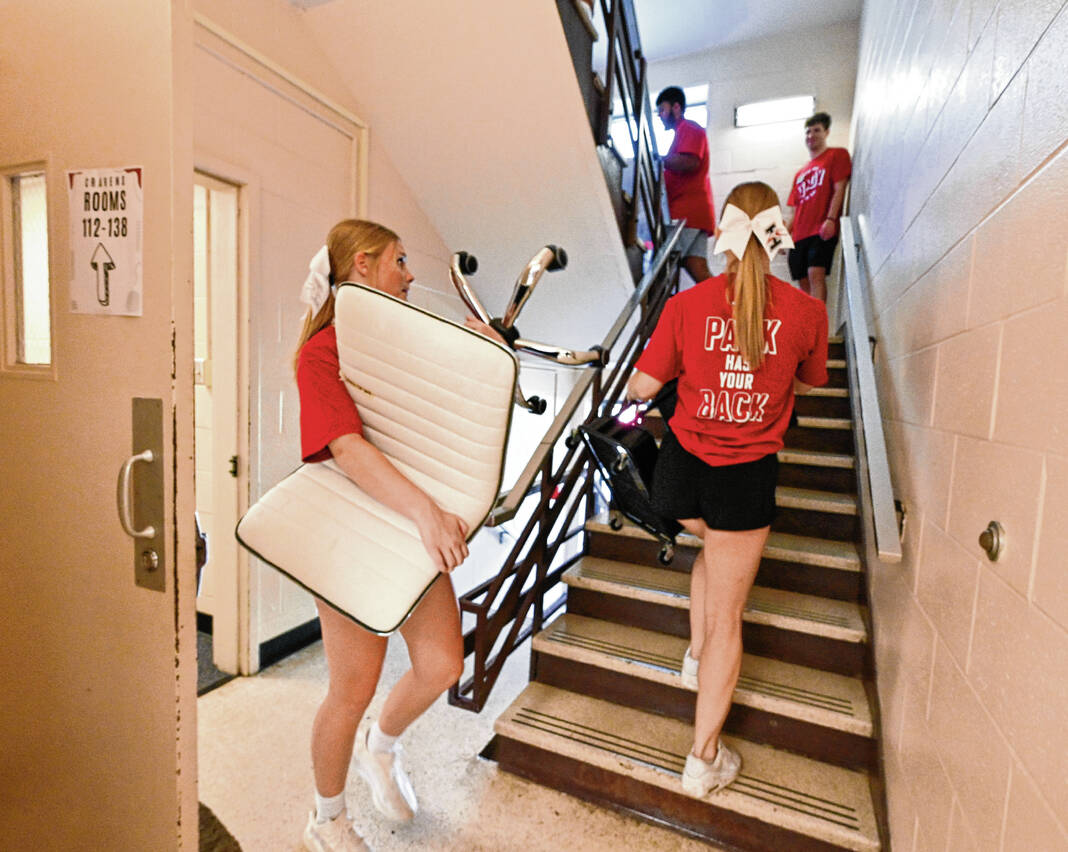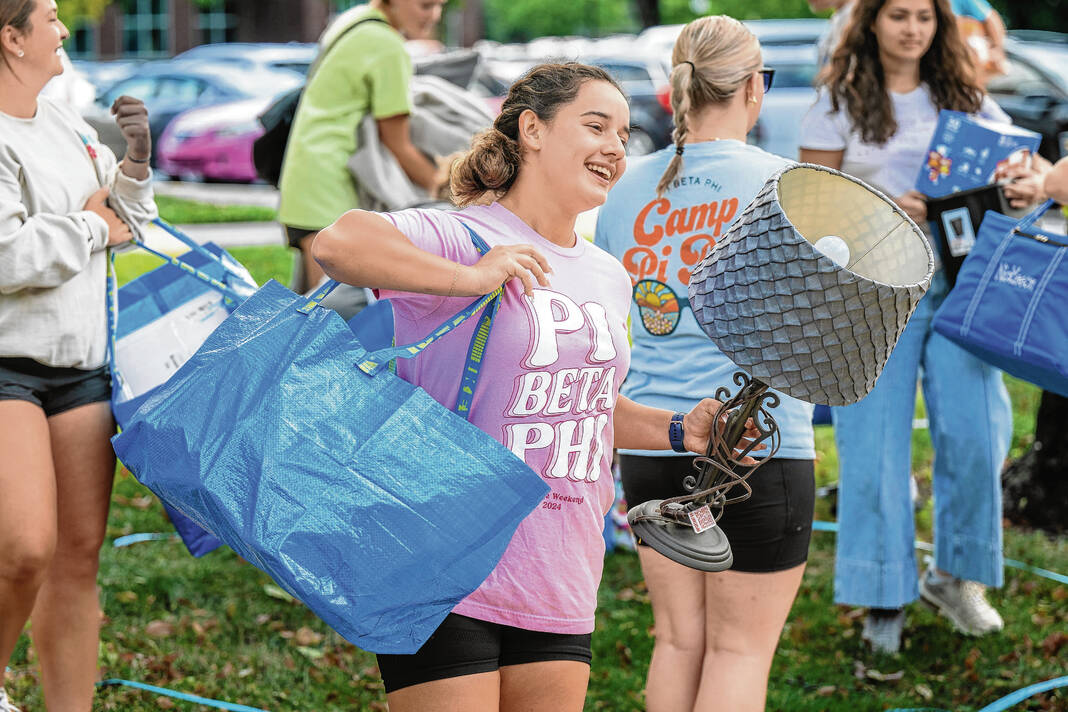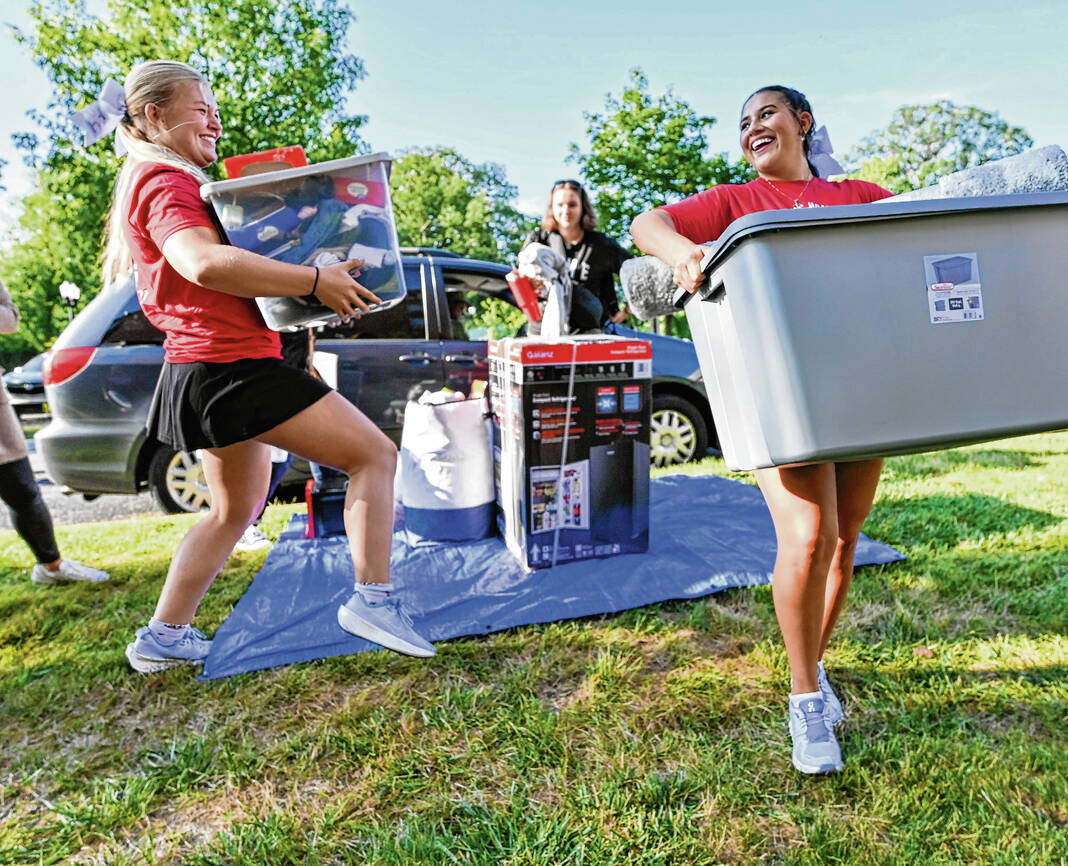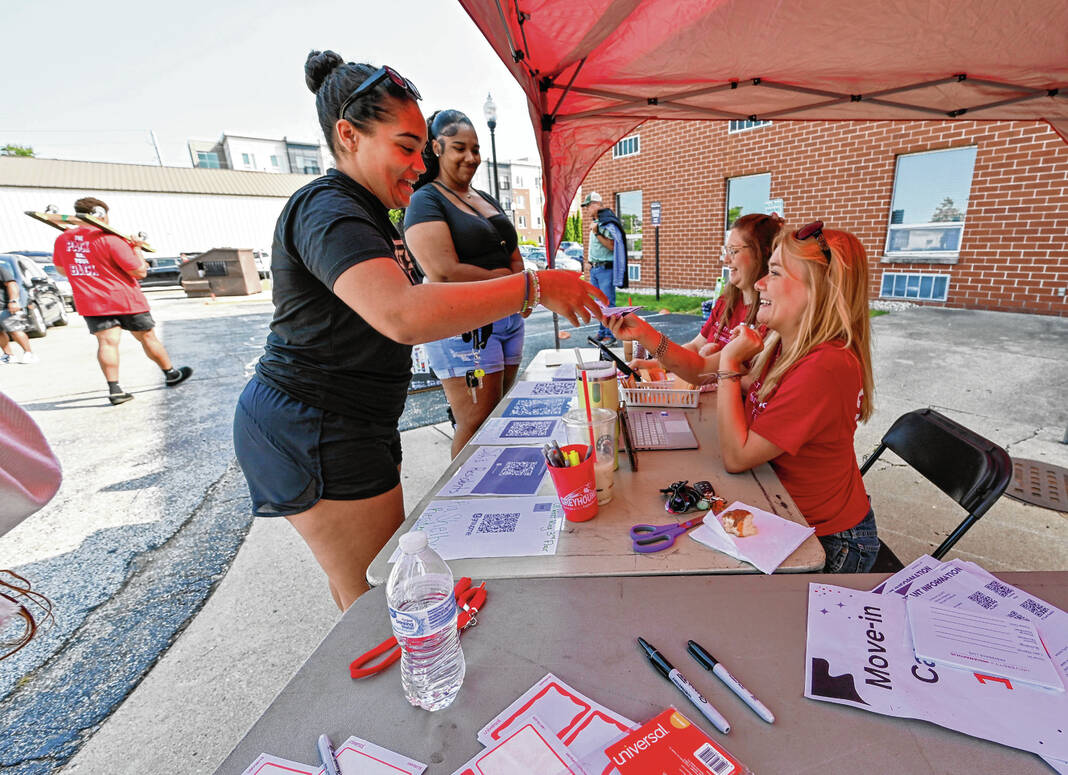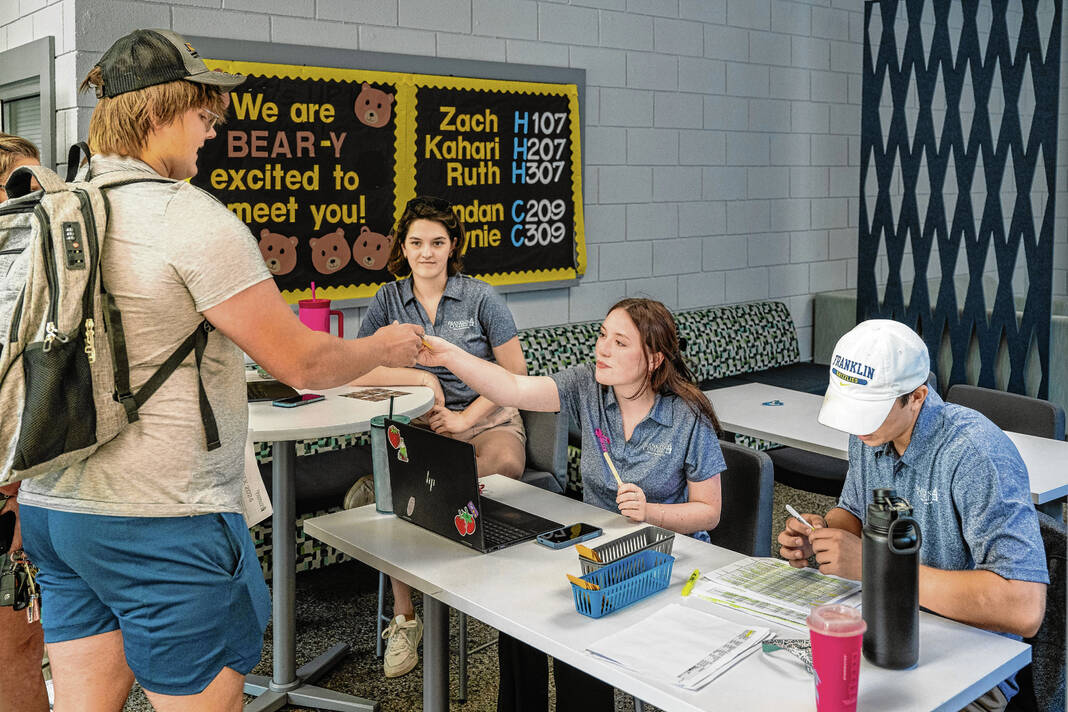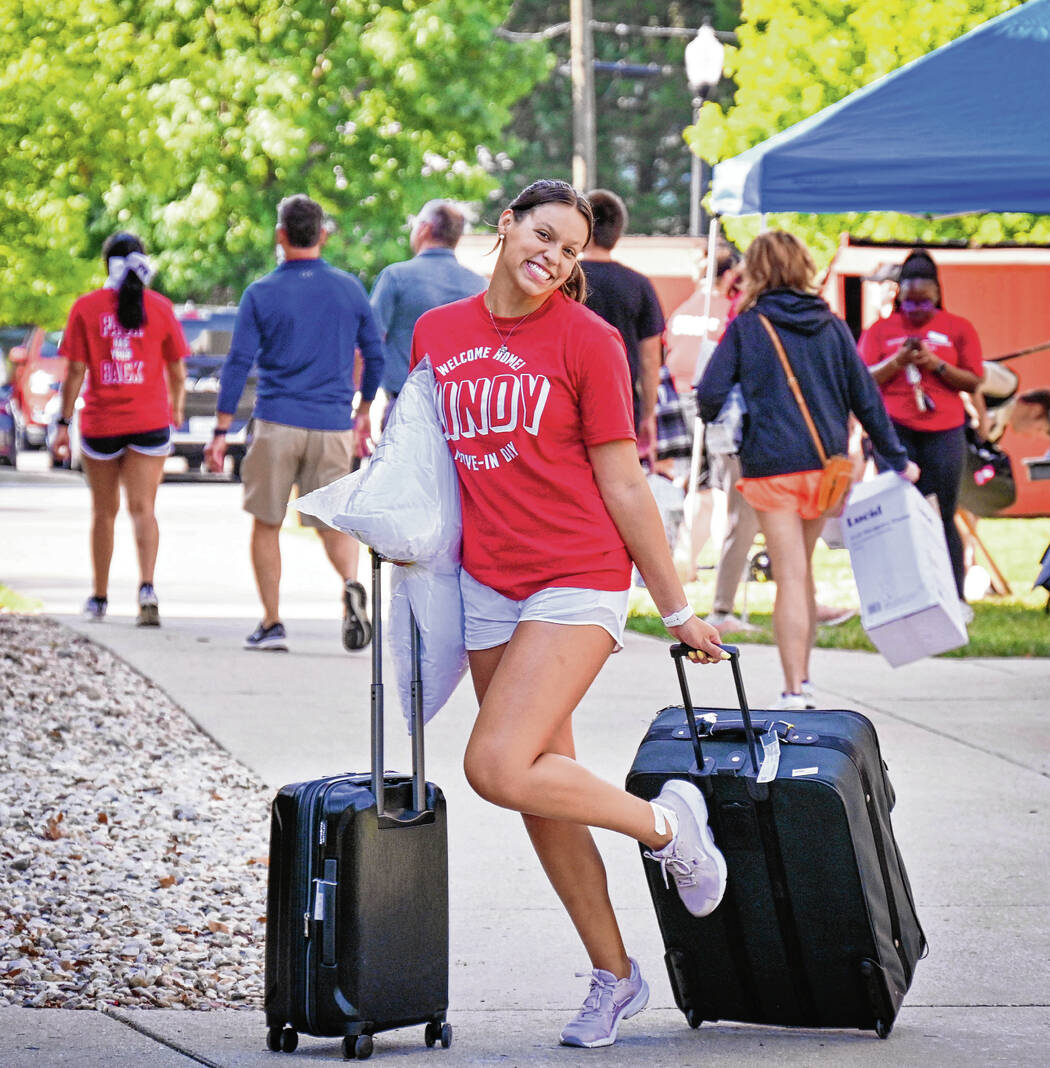
A Franklin College student heads to her dorm with a tote bag and a lamp on Move-In Day Aug. 21. Franklin College photos
Two local colleges are striving for success with this year’s incoming class, despite a statewide lull in enrollment numbers.
According to unofficial statistics, Franklin College hit a record number this year with approximately 353 new students arriving on campus last week while the University of Indianapolis has remained stable with about 800. Statewide college enrollment numbers have stagnated since 2020 and the two schools are exploring different options to find success.
Early numbers show 988 total students are enrolled in Franklin College this year, said Deidra Baumgardner, director of communications. In 2021, there were 962 total students, according to the Daily Journal’s previous reporting.
UIndy has a total of over 3,500 students enrolled in the university unofficially, said Steve Schuetz, interim vice president of enrollment management. In 2021, there were 4,426 total students, according to the Daily Journal’s previous reporting.
Current numbers are referred to as “unofficial” because both schools don’t call their enrollment numbers “official” until after the 10-day drop/add period at the start of each semester.
Facing ‘headwinds’
Kerry Prather, Franklin College president, said there are “a number of headwinds” that higher education has been dealing with. Firstly, there are fewer high school seniors, which he said will continue for at least the next four to six years. Trends also show fewer of those seniors are going to college.
Because of these conditions, Schuetz said the UIndy is expecting stability, rather than growth.
“All those market forces, I just don’t think it’s realistic for institutions to say, ‘Oh, we’re going to grow our undergraduate population by 20% or something like that,’” he said.
The College Going Dashboard from the Indiana Commission for Higher Education shows approximately 53% of Indiana students enrolled in college in 2022. The rate started decreasing steadily from 2017 to 2019 with a larger decrease in 2020. Since then, the rate has stabilized with an annual decrease of less than a percentage point.
Higher education institutions now have increased competition for fewer students, Prather said. He thinks the growth Franklin College has experienced with the incoming class is “really remarkable.” The goal for freshman enrollment was 300 new students and the college exceeded that by 53.
“So at a time when a lot of small schools are really struggling, this is the second year in a row that we have exceeded the goal set at this time, significantly exceeded it,” he said.
Recruitment, retention
Both colleges have implemented different ideas to recruit and retain students. Outreach via digital media has become a strategy for both schools to recruit in the places where students are.
Franklin College has focused on technology through its digital fluency initiative, where students are taught to be proficient in software and platforms that are useful for their majors and future careers. Prather said he thinks it’s distinct among liberal arts colleges and is “the next logical layer of education that these students need.”
Franklin College also has resources like a podcast studio, 3-D printer, maker space, and virtual reality space.
“I think we built it (the digital fluency initiative) out incrementally and it’s just now really starting to capture the attention of students, especially students who visit other campuses and don’t find that particular emphasis as far as the tech aspect of their education,” Prather said. “So, I do think that’s a layer of distinction that we have that’s starting to pay off in significant ways.”
UIndy is using technology to help retain students once they are enrolled. School officials can monitor student behavior, identify risk factors and connect at-risk students to resources like tutoring, counseling, health and financial literacy programs.
The school also allows students to add credentials to their portfolio and notably this academic year, the university has started an online option so students can get their degree digitally.
For both colleges, there has been an emphasis on recruiting all student demographics. UIndy has expanded outreach and engagement to adult, online and graduate students.
“Just looking at diversifying our recruitment markets to be able to sort of offset that shrinking of the traditional markets and be in spaces where today’s learners are,” Schuetz said.
Franklin College has had significant uptick in the international student demographic because of a more aggressive recruitment approach, Prather said. The incoming class of 2028 is the most geographically diverse in the college’s history with students coming from 14 different states and 13 different countries, college data shows.
Franklin College has focused on immersive learning where education in the classroom is applied to the outside world, while UIndy has focused on offering living-learning communities for students, officials said.
Prather thinks opportunities outside of the classroom have helped enrollment and retention numbers at Franklin College. Members of the incoming class have said they are interested in Greek life, study-away experiences and athletics. Nearly 200 students plan to be involved in one or more of the college’s Division III athletic programs, according to the college.
Both Schuetz and Prather said retention of students is also important. Higher education institutions need to make sure there are support systems in place and that students are engaged, Schuetz said. Schools have to create a sense of community and maintain affordability so students can make it to graduation, he said.
Future goals
For UIndy, the goal is to stabilize undergraduate recruitment and enrollment and maintain pipelines for students coming from high school. Another goal is to see more growth among the transfer and graduate student populations, Schuetz said.
“We see that’s one area that we’ve been doing well in, but we think we can continue to make some in-roads really in order to serve the state and needs of the students in the market who want those career advancements, want to create some opportunities for themselves, as well as the industries who need individuals with those skills,” he said.
For Franklin College, the goal is to grow total student enrollment incrementally by approximately 100 students. Prather said the school has found the right staff, leadership, strategy and resources to bring all the pieces together.
“So a lot of things are trending in the right direction and my message to the campus community has been let’s grab this, let’s ride this wave, continue this momentum, take good care of these students,” Prather said. “Let’s make sure that they’re successful and then continue to look for the smartest ways to continue to build this enrollment incrementally over the next several years.”



